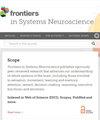小脑对基于恐惧的情绪处理的贡献:与理解自闭症中涉及的神经回路的相关性
IF 3.5
4区 医学
Q2 NEUROSCIENCES
引用次数: 0
摘要
小脑网络传统上被认为与感觉运动控制有关。然而,大量证据表明,小脑的功能延伸到非运动领域,如基于恐惧的情绪处理,这些功能是通过与广泛的大脑结构相互作用来支持的。与小脑对情绪处理的贡献相关的研究主要集中在人类和非人类受试者中良好约束条件反射范式的使用上。从这些研究中可以看出,小脑回路除了编码和储存恐惧记忆外,似乎还关键地参与了对威胁刺激的条件和非条件反应。据推测,这种贡献背后的计算机制可能涉及内部模型,其中实际结果和预期结果之间的误差是在小脑回路中计算出来的。从临床角度来看,小脑异常一直与包括自闭症在内的神经发育障碍有关。重要的是,非典型适应行为和高度焦虑在自闭症患者中也很常见。在这篇综述中,我们概述了目前小脑对基于恐惧的情绪处理的解剖学、生理学和理论理解,以促进对自闭症患者观察到的情绪失调的神经回路的进一步了解。本文章由计算机程序翻译,如有差异,请以英文原文为准。
Cerebellar contributions to fear-based emotional processing: relevance to understanding the neural circuits involved in autism
Cerebellar networks have traditionally been linked to sensorimotor control. However, a large body of evidence suggests that cerebellar functions extend to non-motor realms, such as fear-based emotional processing and that these functions are supported by interactions with a wide range of brain structures. Research related to the cerebellar contributions to emotional processing has focussed primarily on the use of well-constrained conditioning paradigms in both human and non-human subjects. From these studies, cerebellar circuits appear to be critically involved in both conditioned and unconditioned responses to threatening stimuli in addition to encoding and storage of fear memory. It has been hypothesised that the computational mechanism underlying this contribution may involve internal models, where errors between actual and expected outcomes are computed within the circuitry of the cerebellum. From a clinical perspective, cerebellar abnormalities have been consistently linked to neurodevelopmental disorders, including autism. Importantly, atypical adaptive behaviour and heightened anxiety are also common amongst autistic individuals. In this review, we provide an overview of the current anatomical, physiological and theoretical understanding of cerebellar contributions to fear-based emotional processing to foster further insights into the neural circuitry underlying emotional dysregulation observed in people with autism.
求助全文
通过发布文献求助,成功后即可免费获取论文全文。
去求助
来源期刊

Frontiers in Systems Neuroscience
Neuroscience-Developmental Neuroscience
CiteScore
6.00
自引率
3.30%
发文量
144
审稿时长
14 weeks
期刊介绍:
Frontiers in Systems Neuroscience publishes rigorously peer-reviewed research that advances our understanding of whole systems of the brain, including those involved in sensation, movement, learning and memory, attention, reward, decision-making, reasoning, executive functions, and emotions.
 求助内容:
求助内容: 应助结果提醒方式:
应助结果提醒方式:


